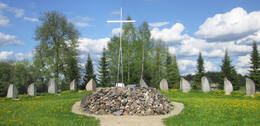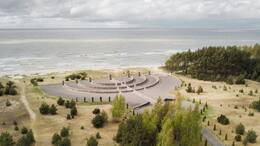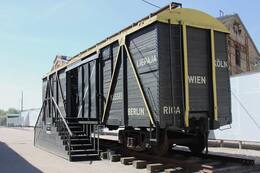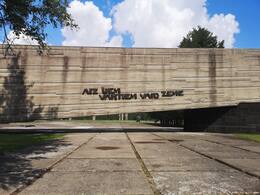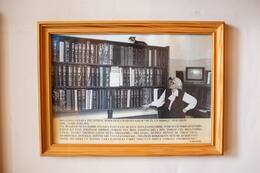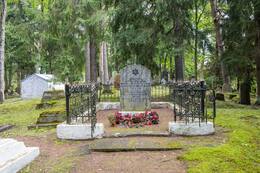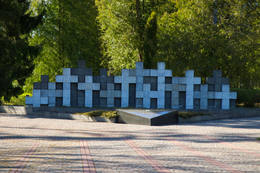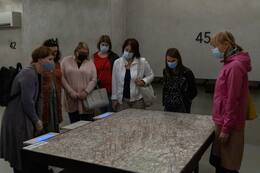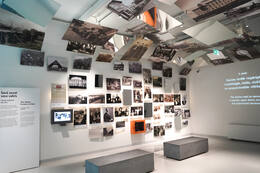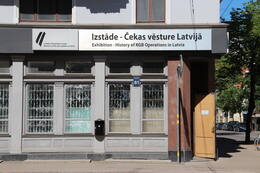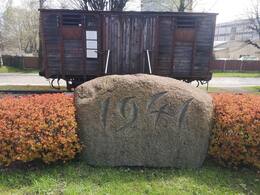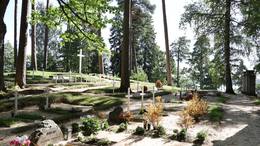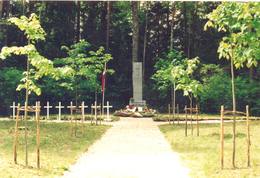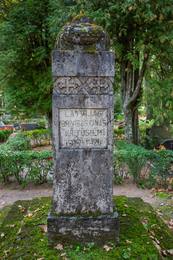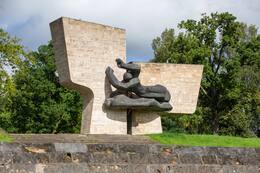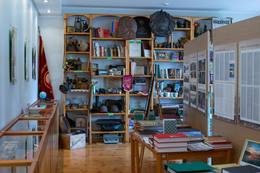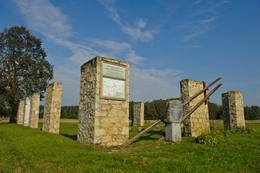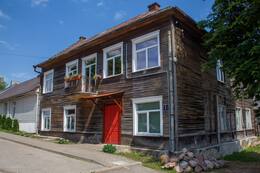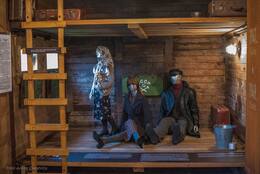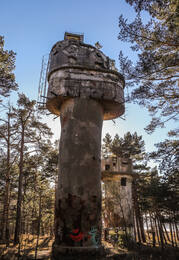Genocide II World War II, IV Soviet Occupation
Genocide (from the ancient Greek word “genos” - race or tribe, - and the Latin “cide” - killing) is an act aimed at destroying, in whole or in part, a national, ethnic, racial or religious group as such: by killing members of this group, physically maiming or mentally traumatizing them, deliberately creating for such a group conditions of life calculated to bring about its total or partial destruction, deliberately limiting the birth rate in this group, forcibly transferring children of one group to live in another group. Genocide includes both a physical aspect - listing specific actions such as, for example, the killing of members of a certain group of people - and a psychological aspect: these actions are carried out with the specific intention of destroying, in part or in whole, a national, ethnic, racial or religious group of people “as such”.
In addition, the 1948 Convention provides that, in addition to the actual commission of genocide, conspiracy (secret or open agreement) aimed at organizing genocide, open and public incitement to commit genocide, attempt to commit genocide, and participation in genocide are criminal and punishable.
The mass extermination of Latvians in the Soviet Union in 1937–1938 is also called genocide or ethnocide, which was part of a broader politically motivated ethnocide against several national minorities living in the USSR during the Great Terror. By order of the USSR People's Commissariat of Internal Affairs (NKVD), "in order to eliminate the work of the Latvian intelligence service and destroy Latvian nationalist, anti-Soviet activities in the territory of the USSR", more than 22 thousand Latvians were arrested, it is known that 16,573 of them were shot and secretly buried in the mass graves of Butovo, Komunarka, Levashovo, Kuropaty Forest and other places. In the countryside, 372 Latvian colonies and collective farms were liquidated, which included about 12,000 Latvian homesteads. The exact number of victims is unknown, because this crime has not been legally investigated and the perpetrators have not been brought to justice.
On June 17, 1998, the Saeima of the Republic of Latvia decided to mark the Day of Remembrance of the Victims of the Genocide of the Totalitarian Communist Regime against the Latvian People on the first Sunday of December each year. Latvia also celebrates two Days of Remembrance of the Victims of the Communist Genocide on March 25 and June 14 to honor the victims of the deportations of March 1949 and June 1941. In turn, July 4 marks the Day of Remembrance of the Victims of the Genocide of the Jewish People.
More information sources
Genocide. Wikipedia. https://lv.wikipedia.org/wiki/Genoc%C4%ABds
Repressions of totalitarian occupation regimes against the inhabitants of Latvia. 1940-1953. Latvian National History Museum: http://lnvm.lv/?page_id=3976
Totalitarian occupation regimes in Latvia in 1940-1964. Studies of the Latvian Commission of Historians. Papers of the Latvian Commission of Historians. Volume 13. Riga, 2004. https://www.president.lv/storage/kcfinder/files/item_1618_Vesturnieku_komisijas_raksti_13_sejums.pdf
Related timeline
Related objects
Memorial to victims of communist genocide
This memorial is situated in Pilistvere cemetery.
Groundwork for the memorial began in 1988, with 300 people rallying to the cause. The joint effort of volunteers continues to this day, with improvements being made to the memorial each year. The idea for the memorial came from freedom fighter Lagle Parek.
At its centre lies a cairn of rocks brought from places over Estonia, from Siberia and from even further afield by Estonian expats. The cairn is crowned by a large cross. The foot of the cross is a symbolic tomb, to which Estonian people bring rocks to commemorate loved ones deported to Siberia.
The cairn is surrounded by boulders, one for each county, designed by Aate-Heli Õun and set in place in phases.
Near the memorial are memorial stones to the victims of the radiation from Chernobyl, to the Forest Brothers, to those conscripted into the NKVD’s labour columns, to Estonian volunteers in the Finnish army and to freedom fighters. These were all designed by Endel Palmiste.
In addition to the cairn, a grove of more than 2000 memorial trees has been planted near the memorial. The grove was designed by renowned landscape architect Andres Levald.
The historic Pilistvere pastorate, serving as the main building at the memorial site, houses an archive and an Estonian History Museum exhibition about the occupation of Estonia.
Memorial to the victims of holocaust in Liepāja
The largest memorial to Holocaust victims in Latvia is located in Liepāja, in the Šķēde dunes. The memorial is dedicated to the memory of more than 3,000 Liepāja Jews killed during World War II. It is in the form of the Israeli national symbol, a seven-branched candelabra known as the menorah. The contours of the memorial, which are clearly visible from a bird’s eye view, are made of split boulders and granite blocks. The ‘lights’ of the menorah are made of granite pillars with inscriptions of verses from the Lamentations of Jeremiah in Hebrew, English, Latvian and Russian.
Riga Ghetto and Latvian Holocaust Museum
The Riga Ghetto and the Latvian Holocaust Museum is located in Riga close to the Riga Central Market and the Riga Central Station. The museum was opened in 2010 on the site where the city's warehouses once were. It is located in the historical part of the city, next to the border of the former Jewish ghetto. The territory of the ghetto is unique, because in terms of architecture it has not changed since World War II. It is a memorial dedicated to the tragedy suffered by the Jewish people. The German policy regarding the Jewish population in Latvia until the end of 1939 was for the German diplomats and politicians to try and pressure the Latvian government to take action against the Jews by restricting their freedom. After the emigration of the Baltic Germans in 1939, the German embassy no longer had as good an access to information on the mood of the population and the events happening in Latvia as before. When the Red Army occupied Latvia, they manipulated the society to gain some support of the Jewish population for the new occupying power. However, after the regime started a crackdown on the society as a whole, the support fell rapidly. As a result of all this, a deep divide had formed between the people. And later on, the next regime – Germany – tried to exploit it. They hoped that the local population would harass and attack the Jews, but that did not happen. So, Germany adjusted their approach and devised a new plan to initially establish a Jewish ghetto and later destroy its inhabitants.
Salaspils Memorial Ensemble
Salaspils Memorial and historical exhibit is located in Salaspils municipality, 1.2 km from the Riga-Daugavpils A6 highway. The Salaspils Memorial was unveiled in 1967 on the site where during World War II the Salaspils Camp was once located. It is a place that was used for Soviet propaganda and is shrouded in myths and half-truths. It is a good representation of the Nazi crimes and Communist ideology that was carried out during each of the occupations. This repressive camp was a part of the German penitentiary system. It had similarities with concentration camps, but it was not the same thing. It was created so that there would not be a disproportionate number of prisoners in Riga prisons. This camp was an “extension of the police prison”. And a variety of people were imprisoned here – Jews, the Red Army prisoners of war, absentees, political prisoners, criminals, prostitutes, members of the Latvian resistance movement, Baltic soldiers in the German Army or police, and others. The camp could hold up to 2,200 prisoners. The main cause of death (~2000) was malnutrition, working conditions, corporal punishment and illness.
Museum of Melānija Vanaga and Siberian dugout
The Melānija Vanaga Museum is located in the Amata village school in Cēsis municipality. The museum showcases materials about the life, literary activity, family and destiny of writer and cultural historian Melānija Vanaga: video content about Siberia and the deported Latvians living there and a Siberian dugout taking its visitors on a trip to the writer’s place of deportation in Tyukhtetsky district, Krasnoyarsk region. The appearance and layout of the dugout form a realistic idea of life away from home. The dugout features unique historical objects brought there from the Tyukhtet Museum: a birch-bark dish known as ‘tuyesok’, a clay mug known as ‘krynka’ and a kerosene lamp. The museum features video interviews with politically repressed people from the municipality and 18 characters from Melānija Vanaga’s book Suddenly, a Criminal: Sixteen Years in Siberia. The museum’s virtual exhibition ‘BE YOURSELF!’ (http://esipats.lv) shows the experiences of five deported children and their parents who were wrongly accused by the Soviet authorities of ‘betrayal of the motherland’.
Varakļāni Jewish Cemetery - a memorial to the victims of German-fascist terror
Varakļāni Jewish Cemetery, at the end of Kapsētas Street.
Two monuments can be seen, which were erected by surviving relatives and friends at the Varakļāni Jewish cemetery after the war.
One of them is located near the cemetery fence, where the mass extermination of Jews took place. The inscription on it in Russian and Yiddish reads: “We will forever mourn our parents, brothers and sisters who died at the hands of the fascists in 1941.” The second monument is located inside the cemetery; at the place where the murdered Jews were later reburied, it also has an inscription in Yiddish and Russian: “Eternal memory to the victims of German-fascist terror – the Jews of Varakļāni, brutally murdered on August 4, 1941.”
Nazi German troops entered Varakļāni in early July 1941 and from the very first days began the restriction of Jews and individual murders. A conditional ghetto was established near the Jewish cemetery, to which all Jews had to move. On August 4, in the territory of the Jewish cemetery, a German SD unit (“Arāja komanda”), with the help of local self-defense forces, shot practically all the Jews of Varakļāni (about 540 people).
Every year on the first Sunday of August, a memorial event dedicated to the Jews killed in Varakļāni is held at the Varakļāni Jewish Cemetery.
Memorial "Wall of Pain"
Art is found in the Litene cemetery.
On June 14, 2001, the memorial "Wall of Pain" created by architects Dina Grūbe, Benita and Daiņš Bērziņš, stonemasons Ivars Feldbergs and Sandras Skribnovskis was unveiled at the Litene cemetery. It symbolizes the resting place of the soldiers killed in 1941. In October 1988, the ashes of 11 officers murdered by the Soviet army in June 1941 were found in the territory of the former Latvian army summer camp in Sita sila, Litene parish. Although they could not be identified, on December 2, 1989, after being consecrated in a service at the Gulbene Evangelical Lutheran Church, they were solemnly reburied at the Litene cemetery.
11 white crosses, a memorial plaque and information boards.
Historical Exposition “The Burning Conscience”
The historical exhibit ‘Fire of Conscience’ is located in Cēsis, near the Cēsis Castle Square. Established in a Soviet-era temporary detention facility, it tells about the occupation of Latvia and reveals surprising and heroic stories of resistance from individuals. The yard features a memorial wall with the names of 643 residents of the former Cēsis district who died in Soviet repressions, including national partisans deported in 1941 and 1949 and those shot and sentenced to death. The exhibit’s timeline encourages visitors to study the course of the occupation of Latvia from 1939 to 1957. Arranged by topics, quotes from local newspapers offer a comparison of the political propaganda of the two occupation regimes. The six cells for temporary detention have survived to the present day in their original form from 1940 to 1941 and the post-war years. Here, the residents of Cēsis district, detained for various anti-Soviet activities, including national partisans, their supporters, young people who distributed anti-Soviet leaflets and other ‘traitors of the motherland’, were held for several days during the initial investigation and interrogation before being sent to the main KGB Building in Riga. Everything here is real: cells with iron doors, built-in ‘kormushkas’ (small openings for providing food), plank beds, a latrine for detainees, a small kitchen with an oven, as well as typical Soviet-era oil paint on the walls. In 2019, the exhibit was ranked third in the national design competition, the Latvian Design of the Year Award.
Museum of the Occupation of Latvia
The museum exhibits the history of Latvia from 1940 to 1991, under the occupation of Nazi Germany and the Soviet Union. ‘House of the Future’ is a reconstruction and expansion project of the Occupation Museum designed by the well-known American Latvian architect Gunārs Birkerts as well as the new exhibit of the museum. The exhibit ‘History of Cheka in Latvia’ was created by the Occupation Museum and it is located in the ‘Corner House’, which is the former USSR State Security Committee (KGB) building. Latvian Occupation Museum was founded in 1993. It tells the long-hidden story of the fate of the Latvian state, nation and land under the occupation of two foreign totalitarian powers from 1940 to 1991. At the end of 2020 the museum had more than 70,000 different historical items (documents, photographs, written, oral and material evidence, objects and memorabilia). Museum specialists have recorded more than 2,400 video testimonials, making it one of the largest collections on occupation in Europe. The events that unfolded in Latvia, Lithuania and Estonia clearly show us what the nations had to endure under the two totalitarian regimes.
Exhibition in the KGB Building "History of KGB Operations in Latvia"
The former USSR State Security Committee (commonly known as Cheka) building is open for visitors. Here chekists imprisoned, interrogated and murdered Latvian citizens who were considered opponents by the occupation regime. There is also an exhibit from the Latvian Occupation Museum on the activities of Cheka in Latvia. Guided tours of the prison cells, corridors, basement and courtyard are available. The house was built in 1911 and it is one of the most beautiful buildings in Riga. Called the ‘Corner House’ by the people, it was the scariest symbol of the Soviet occupation regime in Latvia, and also one of the pillars of power of the USSR. Cheka operated from the Corner House during the occupation from 1940 to 1941 and then again from 1945 to 1991. Tens of thousands of Latvians were affected by direct political persecution. The fight against enemies of Soviet rule continued also after World War II. Cheka’s approach towards its operation slightly changed after Stalin’s death. Physical torture was replaced by psychological terror. The majority of Cheka agents were Latvians (52%). Russians were the second largest group – 23.7%. 60.3% of the agents were not members of the Communist Party. 26.9% of the agents had higher education. The system was designed in a way to involve local people and thus have greater control over the society. Staff documents and service records are located in Russia. And these materials have not been made available to Latvian authorities and researchers.
Victims of Communist Terror Memorial in Torņakalns
The memorial site is located in the Torņakalns railway station in Riga. It is dedicated to those deported in June 1941. Initially it was planned to create a memorial in Esplanāde park, but later it was decided to place it at the Torņakalns station. The memorial consists of five torn stone sculptures symbolising the ruined families and three generations of deportees. The sculptor of this memorial is Pauls Jaunzems and the architect is Juris Poga. It was unveiled on 14 June 2001 by the then President of Latvia, Vaira Vīķe-Freiberga. Next to the station there is a freight waggon and a commemorative stone dedicated to the deported Latvians. The commemorative stone with the inscription “1941” is a 1.2 m high crude boulder. The author of the memorial stand is the sculptor Ojārs Feldbergs.
Alūksne Garrison Cemetery
Located on the shores of Lake Alūksne, on the Kapsētas Peninsula, in the territory of the Great Cemetery.
They began to be created and maintained with the care of soldiers of the 7th Sigulda Infantry Regiment in the 1930s and were consecrated on November 11, 1932. After the restoration of Latvia's independence, the care for the maintenance of the Garrison Cemetery, the identification of the resting places of the LKOK related to Alūksne, and the installation of memorial signs in the Garrison Cemetery was undertaken by Uldis Veldre, head of the Alūksne Brothers' Cemetery Committee department.
Military personnel of the Army of the Republic of Latvia are buried in the garrison cemetery, as well as soldiers and civilians who fell in the fight against the Bolsheviks on July 4, 1941 in Alūksne near Jāņkalniņš and on July 7, 1941 in Ziemers parish near the Prinduli houses.
Most of the burials have white wooden crosses with metal plaques that mention the name of the deceased, their rank or occupation, as well as their date of birth and death.
On December 19, 1990, a memorial plaque was unveiled at the Garrison Cemetery to the Cavalier of the Lāčplēsis War Order, Vilis Spandegs. Typical memorial plaques were also installed for LKOK who died or were murdered in communist concentration camps and were not buried in Latvia. On November 11, 1990, a memorial plaque was installed for LKOK Voldemārs Zaķis, who died in a communist concentration camp.
Karva Brothers Cemetery
Located on the side of the Alūksne - Ape road near Zuši mājas, south of Karva, at the turnoff to Rezakas.
The monument was unveiled on September 12, 1937. The granite stele was made at the O. Dambekalns stone quarry in Riga, after a design by the War Construction Administration architect Vemers Vitands.
In the autumn of 1975, local communists destroyed the monument. On March 30, 1989, the Alūksne District Council made a decision to restore the monument, and on April 30, 1989, a temporary wooden memorial in the form of a Latvian grave marker was installed in its place, made by Jānis Jaunzems, a worker at the State Electrical Factory (VEF). The inscription on it read: “The Karva Brothers Cemetery Monument will be restored here.”
At that time, the nearby Brothers' Cemetery was also improved.
In 1993, thanks to the initiative of Ulda Veldre, head of the Alūksne Brothers' Cemetery Committee, the restoration work of the memorial site resumed. The new monument was made by the Cēsis stonemason brothers Aivars, Austris and Auseklis Kerliņi.
The monument was unveiled on June 11, 1994.
Four soldiers of the 5th company of the Valmiera Infantry Regiment are buried in the fraternal cemetery - Jēkabs Sukse, Pēteris Leitlands, Ernests Puķītis and Gustavs Ozols, who fell in the battles near Zuši on April 2, 1919. The fifth soldier buried in the mid-1930s was Roberts Glazners, a soldier of the Valmiera Regiment who disappeared without a trace on March 31, 1919 near Jaunā muiža. Initially, he was buried as an unknown, but later his name was clarified and engraved on a monument. In turn, the fifth soldier who fell in the Battle of Zuši, Augusts Dzedons (Ziedons), is buried in the Apekalna cemetery.
A memorial plaque has been installed at the foot of the monument to Jānis Goldes (1891–1952), a participant in the Battle of Eels, who died in the communist concentration camp in Inta, Komi.
The second memorial plaque, unveiled on August 23, 1992, is installed near one of the wooden crosses and is dedicated to Corporal Pēteris Jansons of the 7th Sigulda Infantry Regiment, who was murdered by the departing communists on July 7, 1941.
Military heritage monuments at the Dīvaliņas cemetery in Valmiera
Located in the Valmiera Dīvalas (Jānis) Cemetery in Valmiera.
A monument made of Allaži travertine, designed by sculptor Marta Lange and unveiled on September 26, 1937, is visible.
The pillar-shaped monument is topped by a sloping altar, on which stands a wreath of oak leaves and a helmet carved from travertine.
Approximately 80 soldiers who fell in the Latvian War of Independence, as well as those who died from injuries and diseases, are buried.
Nearby is one of the lesser-known works of Kārlis Zāles - the monument "Fallen Roses", which is associated with the creation of the Brothers' Cemetery ensemble.
Nearby is also a memorial to the victims of communist terror - a stone with the inscription: "To those murdered by the communist regime in 1941" and white crosses.
Memorial to the soldiers fallen in World War II
The memorial ensemble in Valmiera was unveiled in 1985. World War II Soviet soldiers who fell in the vicinity of Valmiera and victims of Nazi terror have been reburied in the Brothers’ Cemetery. The authors of the memorial ensemble are sculptors Zigrīda Rapa and Juris Rapa, architects Ēvalds Fogelis, Jānis Lejnieks, Jānis Rutkis and Andris Vītols, and Design Engineer Ivars Veldrums. Limestone from the village of Allaži was used to decorate the memorial ensemble. Its main image is the split linden tree of the Coat of Arms of Valmiera city. Two sculptures on each side of the ensemble symbolise the rhythm of life and death. The figures facing the Gauja river form a semi-circular space, marking the boundary between the past and the present. The main image facing the city is part of an intense arch-shaped form. The figure of a soldier faces the visitors approaching from the side of the city by the bridge, with the diagonal shape formed by the soldier’s hand supporting his deceased companion. On the burial terrace, soldiers have been laid down in rows for those who fought shoulder to shoulder in battle to lie under the same turf. A composition named the Golden Apple Tree lies separately on the lower terrace of the memorial. A granite plaque commemorates the Jews reburied here. Some of the elements, including bronze apples with the ensemble’s message encrypted by the authors, which had been placed under the growing apple tree, disappeared in the 1990s. A QR code next to the memorial gives visitors access to an audio guide with the information available in Latvian, Russian, English, Estonian and German.
Vaidava Parish Local History Permanent Exhibition
Located in the Vaidava Culture and Crafts Center.
An exhibition dedicated to the memory of the deportations of 1949, as well as the participation of the Vajdavians in the barricades in Riga in January 1991, is on display. The exhibition also features evidence of the world wars (mainly printed materials).
Natural and historical objects, manors, history of education, culture, notable people, materials from the collective farm era, household utensils, banknotes, newspapers, magazines about Vaidava parish.
Memorial site for the victims of communist terror in Jaunrauna parish
Located in "Baižēni", Priekuli parish
A memorial site for the repressed was established on the site of the ruins of the “Baižēni” house barn, where 40 residents of Jaunrauna parish were held on the night of March 25, 1949, so that in the morning their path would lead them further to the Lode railway station and Siberia.
Among those repressed were children under the age of 1 and 87-year-olds.
The memorial plaque also contains the names of those who were shot or died in exile. Nearby are memorial stones for the cavaliers of the Lāčplēsis War Order.
Private Exhibition “Abrene Rooms”
The Private exhibition “Abrene Rooms” is located in the town of Viļaka, in a building with a diverse history. Initially, the building was located on the old Marienhausen market square, later it housed apartments, offices and various shops, and during World War II, it was the Latvian self-defence headquarters, the Gestapo and also the Cheka. Several exhibitions reveal diverse events and historical periods in the town of Viļaka and its nearest vicinity covering the time period from 1920 to 1960 when Viļaka was part of Jaunlatgale, later Abrene, district. The exhibit features items from the national partisan camp in Stompaki Swamp, which are related to the national partisan movement in the Latgale region. Documents and photos associated with the War of Independence are also on display. The latest exhibition is dedicated to the once-famous motocross track “Baltais briedis”.
Cattle wagon used for deportations – museum at Skrunda train station
To commemorate the deportations of June 1941 and March 1949, a memorial stone and a four-axle wagon, which also serves as the museum dedicated to deportations, was erected at the Skrunda railway station. This is the first wagon-type museum in Latvia that holds a permanent exhibit of photos, letters, memoirs, documents and various items made by the people deported from the Skrunda station. Skrunda station was a location where deportees were gathered, and one of the three stations in the region to which people from the Skrunda and the Kuldīga area were brought. In 1941, the family of the first President of the restored Republic of Latvia, Guntis Ulmanis, was deported from here to Krasnoyarsk Krai in Siberia.
With the help of deportations, the Soviets dealt with supporters of the national partizans’ and at the same time intimidated the remaining rural population, forcing them to join the collective farms.
Karosta, the Military port of Liepāja (tour)
The Karosta is the largest historical military territory in the Baltics and occupies almost one third of the entire territory of Liepāja. The Karosta is a unique compound of military and fortification buildings on the shores of the Baltic Sea with a special meaning in the history and architecture of Latvia and the world. The Karosta features such military heritage sites as the North Pier and forts, the Redan, Karosta Prison, Karosta Water Tower, St. Nicholas Orthodox Maritime Cathedral, Oskars Kalpaks Bridge and others.
Memorial to Cesvaine residents who fell in World War I and the War of Independence at the Cesvaine Lutheran Church
Located in Cesvaine Lutheran Church and church grounds.
A memorial to parishioners who fell in World War I and the War of Independence can be seen in the church.
In memory of the residents of Cesvaine and its surroundings who fell in the freedom struggle, a memorial site was renovated and consecrated in the church in 2004 with a dedication in poetry by the writer Augusts Saulies.
The plaque also contains all 34 surnames that were engraved on the old plaque. The wooden altar was made by local craftsman Juris Neimanis.
In the church garden, you can visit the memorial site for the victims of the communist genocide, opened and consecrated on March 25, 2003, in the center of which is a monument created by sculptor Bērtulis Buls.
The roof and foundations of the tower of the Cesvaine Evangelical Lutheran Church were damaged during World War II. In the post-war years, the organ, altar, pulpit, and lead frames of the window glass were destroyed. On March 29, 1964, the last service was held in the church, but in 1978, architect Maija Elizabete Menģele developed a reconstruction project for the church for its use as a house of traditions. In 1985, a group of craftsmen was formed to carry out interior reconstruction work. The first service was held in the partially renovated church on August 25, 1990, led by Archbishop Kārlis Gailītis (1936–1992). In 1994, the construction work of the altar and pulpit was completed. On August 17, 2002, Archbishop Jānis Vanags consecrated the partially restored organ.
Source: http://www.cesvaine.lv/turisms/apskates-objekti-cesvaines-novada/cesvaines-luteranu-baznica.html
Stende railway station in narrow gauge railway network and the memorial stone for deportations
The railway line Ventspils - Mazirbe, as well as the Stende - Dundaga extension to Mazirbe with a branch to Pitrags, were intended only for strategic military needs. During the construction of these lines, and afterwards, all civilians were evacuated from the region. The main task of the military railways in the Irbe Strait area was to provide the German army's coastal defence positions with guns and ammunition.
These military-only military railways also connected the three most important lighthouses, located in Oviši, Mikeltornis and Šlītere.
Nevertheless, passenger transport was also provided as early as the years of World War I.
A memorial stone (1989) to the deported Latvians of 1941 and 1949 is located at the Stende railway station.
On 30 October 1919, Stende railway station was occupied by Bermont troops. On 17 November, soldiers of the Latvian army led by K. Šnēbergs attacked the station, driving away a wagon with weapons, war materials and grain. 6 soldiers were awarded the Order of the Order for these battles: K. Bumovskis (1891-1976), P. Strautiņš (1883-1969), R. Plotnieks (1891-1965), E. Jansons (1894-1977).
Reburial site for Holocaust victims
Nazi troops entered Aizpute on June 28, 1941. Already at the beginning of July, individual Jews were shot in the Dzirkaļi Forest and the city park, while the rest of the Jews from the city and the surrounding area were arrested and placed in two city synagogues.
The mass murder of Jews then took place during two campaigns.
Nowadays, a monument has been erected at the reburial site with an inscription in Hebrew and Latvian: “Here are buried the Jews of Aizpute and other innocent victims of the German Nazis, brutally murdered in 1941. We will remember them forever.”
Burial site of Cheka victims at Lake Chumal
The burial place of Cheka victims is located near Lake Chumal in Lībagi parish, near the Talsi - Lauciene road. In 1946-1947, the Cheka shot 14 people here. There is a version that among those shot were supporters of the Forest Brothers.
The Talsi Prosecutor's Office reportedly has information about this case. A more in-depth investigation is needed.
Liepaja Police Building or "Blue Miracle"
In Liepāja, the communist occupation regime's institution, the militia, was located in a building at 19 Republikas Street, which the people of Liepāja had called the "Blue Miracle" since its construction at the beginning of the 20th century. The headquarters of the Cheka, on the other hand, was located at 19 Toma Street. Shortly after the occupation, it acquired the social designation "Red Miracle".
In the course of the investigation of the crimes of the communist regime to date, it has been established that no executions or extrajudicial executions took place directly in either the Liepāja Cheka building, i.e. the “Red Miracle”, or in the prison. All detainees who were in these places, due to the outbreak of hostilities in the territory of Latvia, starting from June 23, 1941, were transferred to prisons in Russia. This affected both detainees who were arrested for so-called “political” crimes and criminal offenders, regardless of whether the person was under investigation or had already received a sentence.
The transfer of prisoners was determined by the order No. 2455/M of the People's Commissar of State Security of the USSR Vsevolod Merkulov of June 23, 1941, which was addressed to the chiefs of the NKGB of the Latvian SSR, the Estonian SSR and several regions of the Ukrainian SSR. The reason for the shooting was terrible and tragic – it was no longer possible to transfer the prisoners to Russia, but it was not allowed to leave them alive. As a result, during the war, extrajudicial shootings of residents also took place in Liepāja, similar to the Riga Central Prison, Valmiera Prison, Valka and Rēzekne militia, and Greizā kalns near Ludza. The aforementioned crime took place in the “Blue Miracle” – the Liepāja militia building, at Republikas Street 19.
Related stories
Memories about Žanis Lipke
The Soviet occupation was followed by the German occupation. The Nazis committed crimes against the inhabitants of Latvia. One of these ethnic groups was the Jews. Initially, ghettos were established, but then the extermination of the Jews followed. Many Latvians saved the Jews from extermination. One of them was Žanis Lipke.
The deportation train secretly photographed near Skrunda Station in 1949
On 25 March 1949, Elmārs Heniņš, a pupil in Skrunda, witnessed his classmates being taken away. He took his camera and climbed a pine tree on a nearby hill to document what was happening, later hiding the pictures.
Star of David at the Dundaga Concentration Camp Memorial Site
After regaining independence, the residents of Dundaga erected a large wooden Star of David at the site of the murder and reburial of Jews near the Mazirbe-Dundagas road, and later the Council of Jewish Congregations and Communities of Latvia also unveiled a memorial stone next to it.
The abilities of the commander of the 19th Artillery Regiment, Captain Jānis Ozols, during the 3rd Battle of Courland
Captain Jānis Ozols was a Latvian officer, a participant in World War II, a Knight of the Order of the Three Stars, whose artillery division prevented a breach of the front during the Third Battle of Courland.
The Battle of Dzelzkalni in the Zūri Forest on February 23, 1946
The winter of 1945/46, the Brass Group spent in the Zūri forest in the Dzelzkalni area, where several bunkers had been built. Approximately 40 partisans lived there. On February 23, 1946, the camp was surrounded by the USSR Internal Affairs troops and a fierce battle took place.
Extrajudicial shooting of civilians in Liepāja's "Blue Miracle"
Extrajudicial killings in Latvian territory during the war, in late June and early July 1941, were the last manifestation of repression and violence in the first stage of the communist occupation, which ended with the entry of Nazi German troops into the entire territory of Latvia.
The reason for the shooting was terrible and tragic – it was no longer possible to transfer the prisoners to Russia, but it was not allowed to leave them alive. As a result, during the war, extrajudicial shootings of residents also took place in Liepāja, similar to the Riga Central Prison, Valmiera Prison, Valka and Rēzekne militia, and Greizā kalns near Ludza. In Liepāja, this crime of the Soviet occupation power was carried out in the “Blue Miracle” – in the Liepāja militia building, at Republikas Street 19.






